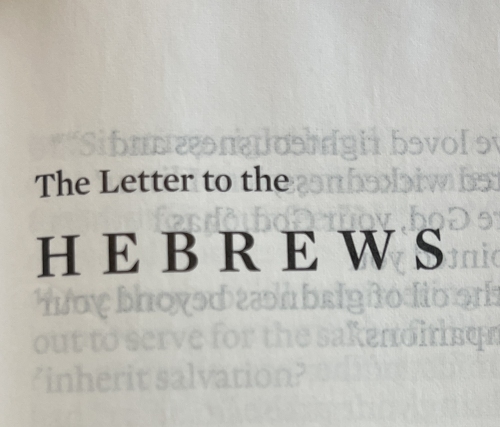The Most Underrated Verse in Holy Scripture? – blog 2/17/23
The Audience of Hebrews
This was a church in crisis for several reasons: it had lost its original leaders, it was under constant attack, some members were failing to fellowship together, and some had already defected (apostatized). There was a perfect storm brewing. (Heb 2:1; 3:12-15; 4:1-2; 5:11-12; 10:23-27; 12:12-17, 28-29; 13:7,17)
The Book of Hebrews was like a dart thrown by a master dart player.
Stand Up For One Another!
Sometimes God gets us all alone with Him in certain life situations, but quite often we're NOT meant to go it alone.... we're meant to function as a body to overcome life's trials, together, by faith, to the glory of God. Heb 12:12-13, 1Co 12:12-27
Have You Forgotten??
We're all "wretched" (see Rom 7 & Rev 3) and nothing less than that! Mat 5:21-22,27-28
On the Genre of the Book of Hebrews
- “[Hebrews is] the only completely preserved homily [from this period]” – H. Thyen
- “[Hebrews is] a parenetic homily in the Jewish-Hellenistic tradition.” - Philo
The Purpose, Plan and Genre of Hebrews
Jewish-Hellenistic homilies drew heavily from the Pentateuch (first 5 books in the Bible) and Psalms, which is precisely what the writer of Hebrews did.
The Purpose, Plan and Genre of Hebrews
The overarching theme of the Book of Hebrews is parenetic (persuasive). Biblical and theological exposition was subordinate to the writer’s parenetical “word of exhortation”, which was meant to induce an emotional response. It is a homily (sermon), laced with rhetorical language, from a shepherd to a group of well-known sheep for the sake of encouragement. (Heb 13:22; 1:1-4; 1:5-4:16; 5-6; 7:1-10:18; 10:19-13:25)
Remember This!
Hebrews is a book of encouragement with Jesus being the substance of said encouragement.
The Difference Between Exposition and Parenesis
The goal of exposition is to explain something (e.g., when a NT writer explains an OT passage). The goal of parenesis is to persuade (e.g., when a writer knits together Biblical doctrines with circumstances to encourage someone to think or act a certain way).
The Purpose, Plan and Genre of Hebrews
The overarching theme of the Book of Hebrews is parenetic (persuasive). Biblical and theological exposition was subordinate to the writer’s parenetical “word of exhortation”, which was meant to induce an emotional response. It is a homily (sermon), laced with rhetorical language, from a shepherd to a group of well-known sheep for the sake of encouragement. (Heb 13:22; 1:1-4; 1:5-4:16; 5-6; 7:1-10:18; 10:19-13:25)
The Rhetoric in Hebrews
- Prologue: v1:1-4
- Thematic Statement: v1:5-4:16
- Statement of Plausibility: ch 5-6
- Demonstration of Proof: 7:1-10:18
- Closing Inspiration: 10:19-13:25
